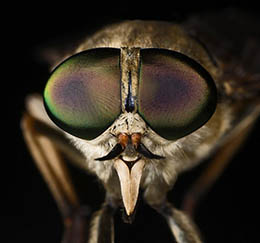Biological Life
As was said on the page about morphing, organic matter has more than one state of equilibrium simultaneously. Therefore, organic matter is a more complex form of matter. It takes longer to find the correct rules on which a particular form of organic matter behaves, because of these different states of which each attributes to the properties of the material.
States of equilibrium are one thing that links biological life with the transformation sequence. But there are more ways in which biological life links to the sequence. One such way can be revealed by observing the shape of living creatures. Some organisms have spiral shapes in them. Other organisms comprise of helix shapes. The shapes of living organisms are for at least a great part defined by vortex movement.
Why this is so is not exactly sure. The common answer to this is that living creatures are made of complex vortices. Yet these vortices do not follow the same rule as the vortices that we know from studying inorganic matter. The first obvious difference is that the movement is different. Likely these vortices are also more complex in the way that they manifest a new, more complex form of movement. A second possibility is that living organisms are not vortices, but that at a period during growth, their shape was defined by vortex movement, and that shape that remains as recognizable vortex shape is like a fingerprint left by the influence of the vortex movement.
Plant life is mostly higher dimensional than animal life. The dimensionality of plants is often one or two dimension levels higher than that of the average living mammal. This can be determined both by the shape of plants and animals, and by the effect that plants and animals have on humans when consumed (see page further below).
Left and Right Turning
Spirals can be binary. These spirals are are a combination of the two spirals with an opposite rotational flow, which are connected by a bridge. In organic life you will never find a bridge in the anatomy of animals. Perhaps this bridge does not exist for animal life, or perhaps the bridge does exist but not in a visual form. A bridge however does exist in organic life as a state of equilibrium. Resin, petroleum and slime are all organic substances whose characteristics are controlled by a bridge. These are all sticky substances. What is known is that the two opposite spirals relate to the male and female side of the sequence. Left turning spirals are male, right turning spirals are female (perhaps it is the other way around, the current convention was chosen randomly).
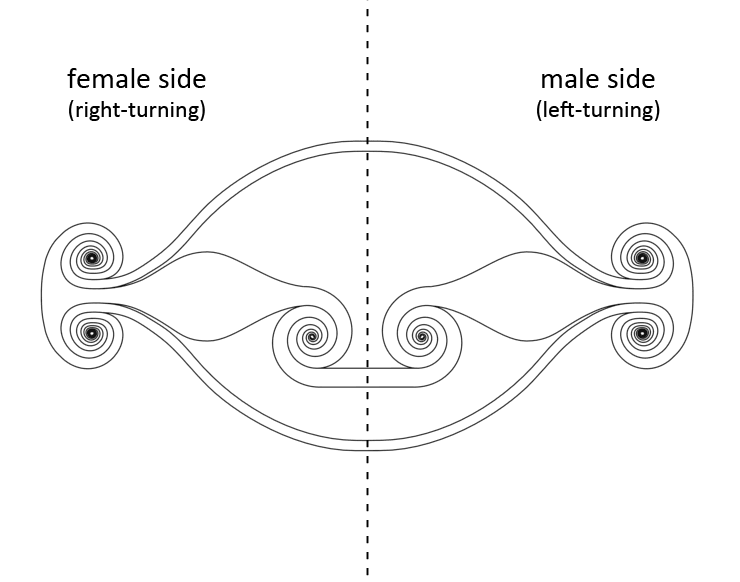
THE LEFT AND RIGHT SIDE OF THE OUTER BRIDGES RELATE TO THE MALE AND FEMALE SIDE OF THE SEQUENCE
I will sometimes refer to these right and left turning movements as clockwise (CW) and counter-clockwise movements (CCW). There is no rule yet as to which side of the sequence is the clockwise movement and which is the counter-clockwise movement, as there is no reference axis that includes a direction to establish a right-hand rule. But perhaps a method for that could be possible once we learn more about the sequence.
Plant Life
Most plants externally do not move in any other way than by growth. Yet this growth of plants does not appear to be a vortex flow movement, nor does it appear to be sequential morphing. Yet it appears to be some kind of morphing. I do not need to say that this form of movement is very slow. Plants do not appear to be moving. Therefore vortices that give shape to plant life are like vortices frozen in time (I first heard that say by a person named Charles Gilchrist).
Plants are like vortices frozen in time
Internally there is also movement which we humans do not see. Nutrients within the plant are transported from the bottom up. This movement of nutrients might perhaps relate to vortex flow movement, but that is uncertain.
The shapes of vortices are sometimes quite well to recognize and thus possible to classify. Most of these vortices are located somewhere close to the central balance point. The highest dimensional vortex within the first half-cycle that appears to give shape to plant life is the revolute. So far I have not found a belt or a scroll ring in plant anatomy. Below are a few examples of recognizable shapes of vortices that give shape to these organic lifeforms.
Lowmorph Bulb
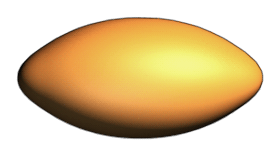 |
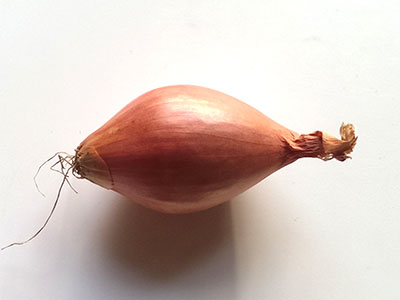 |
Lentillion
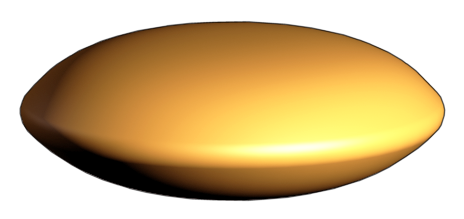 |
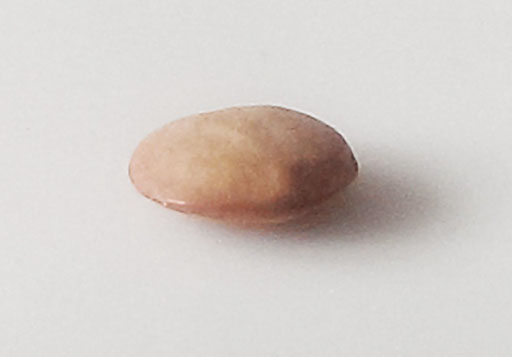 |
Pilaster - Revolute
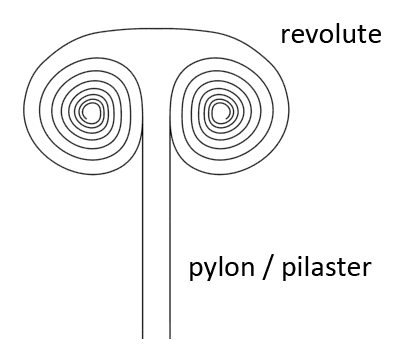 |
 |
The next examples are photographs of bracket fungi. These bracket fungi are shaped by the same vortex movement as the disk vortices from the third half-cycle (second cycle), yet they do not form a complete circle. Their circular form is by maximum about 200 degrees complete.
Lentillion
 |
_From(geograph.org.uk)_UnderCCBYSA2.0.jpg) Image by Des Colhoun (Wikimedia), under CC BY-SA 2.0 license |
Mirage
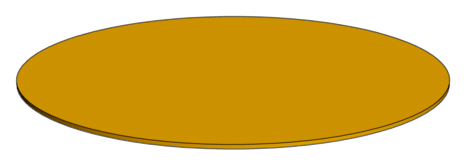 |
_UnderCCBYSA3.0.jpg) Image by Jason Hollinger from Mushroom Observer, under CC BY-SA 3.0 license |
Sinusoid Deformation of a Mirage
 |
_UnderCCBYSA2.0.jpg) Image by Derek Harper from geograph.org.uk, under CC BY-SA 2.0 license |
Pilaster & Cradle
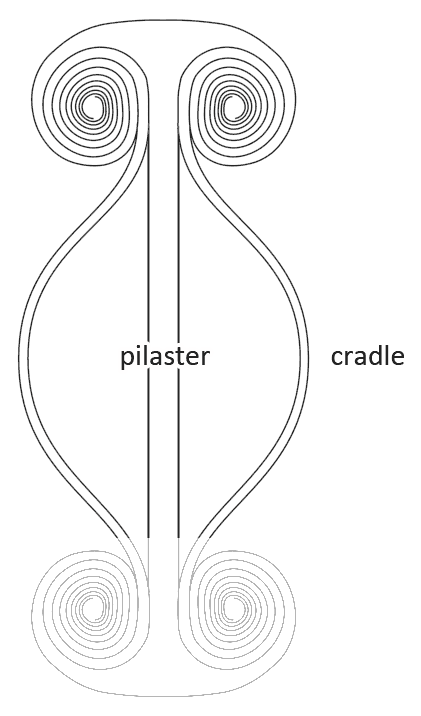 |
_UnderCCBYSA3.0.jpg) Image from Rayabhari (Wikimedia), under CC BY-SA 3.0 |
Bubble
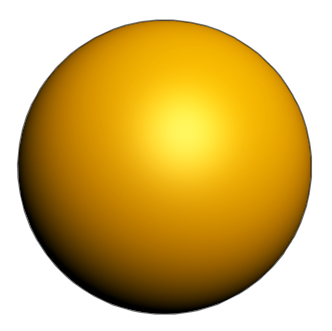 |
_PublicDomain.jpg) Image by Mdakin (Wikimedia) |
The last two examples form an interesting puzzle. Both these fungi have the shape of a net made of hexagons and pentagons build into them. Yet the vortices that they represent do not show this net pattern in their shape, yet these nets do form the same shape of those vortices.
One possible reason is that these wire patterns show the directional paths of the meridians. So this might provide us with information about the build-up / the anatomy of those vortices. What does reveal that these vortices are related to the cradle and the bubble is an experiment with oil and foam. The image below shows what happens when oil, with addition of the right surfactants, is added to foam bubbles, then the same kind of patterns emerge that are shown in these plant forms.
.jpg)
Image from a project managed by Arne Skauge
Trees Hit by Lightning
Sometimes, when a tree is hit by lightning, a helix pattern emerges on the damaged bark of the tree. I seems that the electrical charge of the lightning impact prefers to follow a certain route on the bark of the tree, that could perhaps be caused by the existence of some kind of channels in the tree that attract the lightning streak. On the photo below you see one such tree that was hit by lightning.
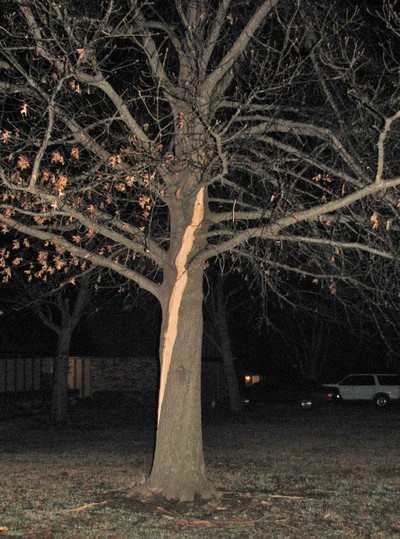 Image courtesy of B.Salwaechter |
 Image courtesy of B.Salwaechter |
My assumption is that this is one proof for the existence of the left and right turning movement in the growth pattern of a tree, which are the same kind of movements we find in vortices. Under normal circumstances, we can not see the left and right turning movement in the trunk of a tree, nor can we see the left and right turning movements in vortices, unless there is only a rotation in one direction. What we see in vortices is the sum movement. These individual movements are what I've named 'meridians', as I've previously explained.

Many times when a tree is hit by lightning, the impact will form one vertical stripe, without any rotation. It is likely that the meridian movements within the trunks of trees consist of al least three peripheral components: left-turning movements, right-turning movements, and movements straight up. These three movements together form a braided pattern.
The photo below shows another tree that was hit by lightning. In this tree, the lightning has formed at least 5 rotations around the trunk (you can click on the image for a larger view). When looking at an example like this it seems unlikely that the helix pattern that has emerged is merely a coincidence. The photo suggests that there must be a clear mechanism as to how these helix patterns are formed.

Image courtesy of David B.Frankhauser
If this assumption about the cause of these helix-patterns on the trunk of trees is correct, than this could proof the existence of the individual left and right turning movements, and it would show that the growth pattern of trees is closely related to vortex movement. There are only a few examples on this website that show the existence of the meridians, this is one of them. Still, the best proof for the existence of the meridians is the sonic boom that a bullwhip can produce, which is shown on the page about tension and compression.
Animal Life
The shapes of living beings are also formed by vortex movement. Living being are made out of a huge number of vortices, yet at the largest visible scale size the number of vortices are just a few. These largest vortices are what constitute the known core meridians within the human anatomy found in Chinese medicine. The smaller meridians from the smaller vortices we might not be able to detect with the same methods applied by the Chinese. At smaller and smaller scale sizes the number of vortices present in the human body progressively increase. When we include all smaller scale sizes, then the number of vortices within the human body could be either a huge number, or could be considered infinite.
The human body also consists of many different materials, with many different states of equilibrium. As a whole, living beings are complex organisms, whose life can be described by the forces and reactions that arise from vortex movement, and all the physical effects that can be linked to the behavior of states of equilibrium, and the dimensional characteristics of specific locations within the transformation sequence.
Despite that at the largest scale size, the number of vortices that constitute the shape of a living being are limited, despite that those shapes are in most cases hard to identify as shapes from the parts of the transformation sequence that we know so far. Reason for that is that the shape of vortices that form living creatures are more complex, because they are vortices that are more complex versions of some of the simpler vortices which we already know today. But still some of these shapes are recognizable as to the shape of the vortex which they represent. Below are a few such examples.
Helicone
|
|
 Bumblebee bristles under microscope |
Swirl
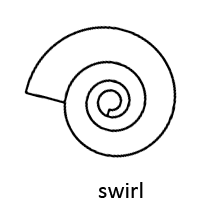 |
_PublicDomain.jpg) Image by Katrin-die-Räuberbraut, Wikimedia |
Swirl – Amplicone – Bulb
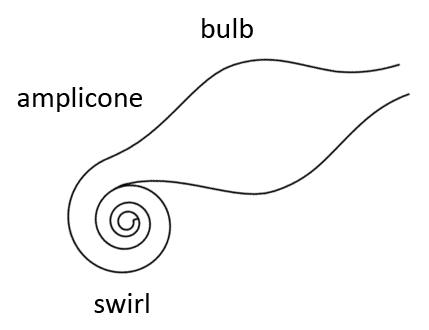 |
.JPG) Image from FlChams |
Suprabell
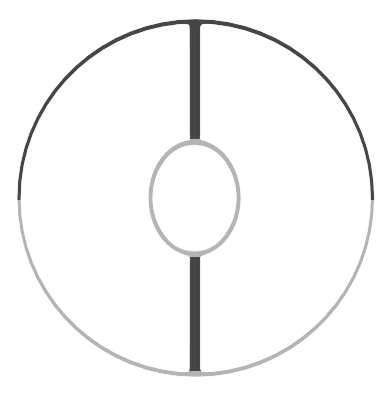 |
_PublicDomain.jpg) Image from PublicDomainPictures |
Unrolled Swirl – Amplicone - Bulb
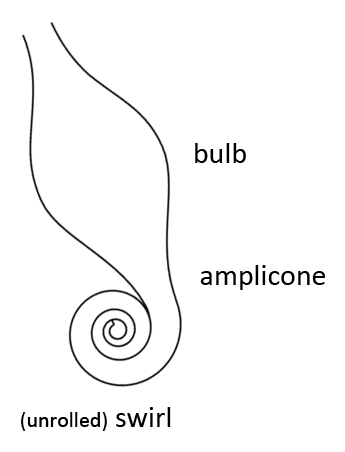 |
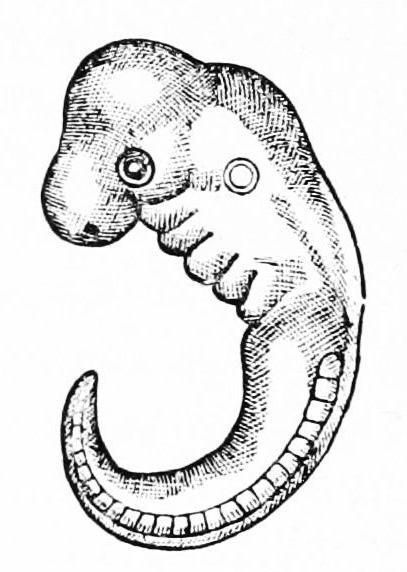 Image from Popular Science Monthly Volume 42 |
Core and Periphery
Vortices have a core and a periphery. The periphery forms physical matter, while the core is electromagnetism. The core of a vortex is not visible, and it can not be observed directly. There are only a few clues that strongly hint the core of a vortex exists, and that its force of movement is that of electromagnetism, or something close to electromagnetism.

One of these clues is the core movement through vertebrates (animals with backbones and a skeleton). The main core, thus the core of the largest vortex that forms the shape of a vertebrate, are the nerves that run through the spinal cord of the lifeform. The central nervous system of humans and animals are what constitutes the core movement of vortices.
This explains why vortices that are higher dimensional than the revolute can be broken into smaller pieces and still persist without breaking down. Vortices like the laminar belt, scroll ring and wake belt are vortices without a core, they only consist of a periphery. That, combined with the fact that they have many meridians, of which some of these meridians remain complete when a part of the vortex is removed, explains why these incomplete versions of these vortices can continue to flow as a stable vortex. Vortices with a core, like the pilaster, bulb, and helicone, can not continue to exist when they are cut in half, instead they become unstable and break apart.
Do all lifeforms see 3D?
To be able to see how an environment looks like, despite of the number of dimensions that environment consists of, we need to see the result of the image of that environment in a three-dimensional coordinate system. If we humans had eyes that allowed us to see in only two dimensions, then we would know too little to make our way within the world that we live in. Three dimensions is the minimum we need, four is too complex for us to understand. So the world around us is projected, by our senses, to three dimensions. It is likely, not certain, that for animals this same principle also applies. They too need to see things in three dimensions to be able to use the information received by their eyes to be able to walk, fly or swim around on this earth. Yet this is not completely certain.
However, it is even less certain that the scope of dimensions that is used to build that 3D image as a result of a projection is the same with animals as it is with humans. It could very well be that the central balance point for a dog or cat lies at a different location, further down or further upwards in the sequence. And that the range of dimensions that they perceive through their senses, thus the number of dimensions that are projected at any given time, is higher or lower than the human range of perception. In that case, a dog or cat could see a world that is different from what we humans see with our eyes.
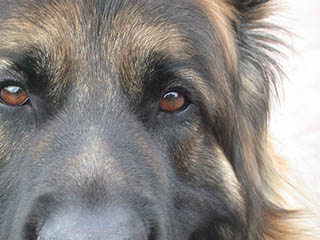 Close up on the face of Toby, a German Shepherd Dog. Image by Andy Mabbett, Wikimedia, under CC BY-SA 3.0 license. |
|
If this is true, than I expect that the difference between the human visual perception of the world is only slightly different than that of a cat or dog. If you compare the eyes of a dog or cat with that of a human, then the anatomy shows great similarities. The central balance point might perhaps only have a slight offset compared to the central balance point for human beings. But if you compare the eyes of an insect with that of a human, then the difference is much greater, and it is more likely that the scope of dimensions seen by an insect is in a much different range than that of a human. An insect might see a whole different world than we do. They see what is more significant to them, that what enables them to function within this world.
Size as a Distance
To understand the consequences of size, it is in many cases required to see size as a distance, whereby shrinking and enlargement can be seen as a movement along an imaginary axis. Our own position on this imaginary axis is determined by our own physical size. Objects are further away from us when their size differs more from our physical size. If an object grows to be larger than us then that object is moving away from us in the positive direction of the axis. When an object shrinks to be smaller than us then that object is moving away from us in the negative direction of that same axis. The mesocyclic scale level is where we humans appear to reside, it is the scale level that we most consciously experience in life. Both the macrocyclic scale level and the microcyclic scale level are further away from our human perception. What resides within those scale levels does influence our senses, but not nearly as obvious as all that is within the mesocyclic scale level does.
A phenomenon that hints that size can or should be seen as a distance is the degree to which we humans can or can not connect with animals of different sizes. Dogs, pigs and seals are among the animals that we humans can bond with better than many other non-human beings. We recognize many of their emotions, we can effectively make eye-contact with them, we can communicate with them to great extent and we can become friends with them. In cats we find these same characteristics, we can bond with them as we can bond with dogs... but slightly less easy. Cats are smaller than most dogs. We have a little bit less perception about what their actual emotions are as compared to a somewhat larger animal. Or better said, it takes slightly longer to learn what a cat wants, feels or thinks as compared to a dog. Rats and guinea pigs are one step more difficult to perceive for us humans. It is also more difficult to effectively make eye-contact with these smaller animals. If we look at the bigger animals then we observe the same thing. We humans do not bond with an elephant or giraffe as easily as we can with a dog.
If we look at fish, then dolphins are probably among the aquatic creatures the we most can bond with. We can bond with dolphins, we recognize some of their emotions and we can communicate with them quite effectively, although it takes more effort to master. Most other fish are difficult or nearly impossible to communicate with, and we barely recognize their emotions. A mackerel does not even appear to be influenced by our presence other than that it swims away from us, and a whale does sometimes seem to be effected by our presence, but it talks in sound waves that have no meaning to us and moves so slowly that it is difficult for us to comprehend its body language.
Another step further away from us are the insects. Here it is virtually impossible to perceive any of their emotions other than assuming it by the actions that they take. We assume that a spider might be scared when it runs away from us, but we can not verify by other means if this is true. We can not make eye-contact with insects, nor can we effectively establish a bond with them, there is also virtually no communication between insects and humans. If we go down to a smaller scale level, such as the micro-organisms, then their world is even more alien to us. We humans understand virtually nothing about the emotions of the creatures that reside in this scale level. Micro-organisms appear to be living very far from us on the imaginary axis, so far that we can not see any of their emotions or make any direct contact with them.
Magnetoception
Take a look at the video below. It is a rare phenomenon but it does sometimes happen. Ants that walk in spiral-like rotations, going on continuously without an apparent reason.
The path of these ants looks very much like a spiral, closest possible shape is likely to be the disc spiral. And a disc spiral only has a core movement, thus it is entirely electromagnetic. It is likely that these ants are following the magnetic field lines of a vortex, and that vortex could be the disc spiral. To be able to investigate if such a theory is correct one should look underneath the ground where this ant spiral occurred, it could very well be that electric wiring, or some other source of electricity is present close beneath the ground.
The ability of animals to detect and sense a magnetic field, and use that detection for the purpose of gaining a sense of direction, altitude or location, is called magnetoception (or magnetoreception as it was first referred to in 1972). This sense has been proposed to be the explanation as to how vertebrates and insects navigate, and is likely used by animals to gain a sense of the map the environment. For navigation over long distances, magnetoception is made possible by the detection of the Earth's magnetic field.
Human Nutrition
Organic matter has multiple states of equilibrium simultaneously, therefore it is more difficult to classify any organic material to the exact locations in the transformation sequence that are linked to its behavior. Still it is possible for us to to determine the exact states for every material that we can find, because for every state there is more than one way to find out. One way to learn about the dimensionality of an edible organic material is by the effects that it has when consumed by a human being. High dimensional organisms have a high dimensional effect on the human body, while low dimensional organisms have a low dimensional effect on the human body.
Whenever you eat something that is high dimensional, your body tends to become a little bit higher dimensional. Whenever you eat something that is low dimensional, your body tends to become a little bit lower dimensional. The human body needless to say is a lot bigger than a meal that we consume, and the effect that the food has on your body after being processed in your digestive system does not occur evenly throughout the entire body. Foods that we eat affect some regions of the body more than they do other regions. But the overall physical effect is that which coincides with what the characteristics of dimensionality are for that specific organism that is consumed.
The effects can be found in how strong we feel, how energetic we are, in the amount of stress or relaxation that we experience, how much we're able to cope with warm and cold temperatures, in the amount of hours that we are able to sleep, in the quality of our skin, in how we behave, and in how we think.
We humans need both high dimensional foods and low dimensional foods to survive. Yet high dimensional food we require in somewhat bigger volume than low dimensional food. A meal as a whole needs to be high dimensional, but only slightly high dimensional. The combined dimensionality of the whole meal needs to be close above the central balance point. The more a food deviates from the central balance point, the less larger volume of that food we can eat. Higher dimensional foods can only be eaten in small amounts, but we do require foods that are higher dimensional. Same holds true for lower dimensional foods. We can only eat lower dimensional foods in small amounts, but we do require lower dimensional foods in these low amounts.
No food is purely high dimensional. And no food is purely low dimensional. Every food contains components of both. Yet the overall effect is one that is either high dimensional or low dimensional, but can be close to the central balance point.
Bio-antennas
We are used to think that antennas are made by humans. But some animals also use antennas. Like humans, animals too can use electromagnetic wave signals for communication. It is already known for a long time that some animals are able to use infrasound or ultrasound for communication. Yet the use of radio signals by animals is something for which until now very little evidence has been provided. It is known that migrating birds use the earth's magnetic field for navigation, and some insects can detect ultraviolet patterns on flowers. Some animals appear to be sensitive to electromagnetic waves, but a more precise observation of the use of radio signals between two individual animals of one species has not been determined.
But now that we know the shape of a large part of the transformation sequence, and the shapes of the vortices in that sequence, we might be able to spot these same shapes in the anatomy of animals, and therefore determine which body parts could provide communication through wave signals.
Moth Tongue
Sometimes we find spirals in the anatomy of living creatures. One such occurrence is the spiral tongue of a moth. The spiral looks more like a disc spiral than a swirl spiral. The spiral is therefore assumed to be low dimensional, and it mostly consists of a core movement, it only has a small periphery because it is an highmorph disc spiral.
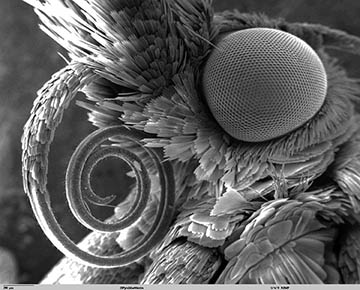 Image by Dartmouth Electron Miscroscope Facility |
 Spiral Antenna |
Humans use their mouth and tongue for communication. It could very well be that this moth tongue is also used for communication, but not by sound waves but by electromagnetic waves. We humans also have build devices that use similar spiral shape for radio communication.
Now take a look at the image on the left below. It shows a closeup of another species of moth, the Luna Moth. This species does not have a spiral tongue, instead the male luna moth has two feather-like antennae extending from the top of its head. Its shape shows similarities with a log-periodic dipole array antenna.
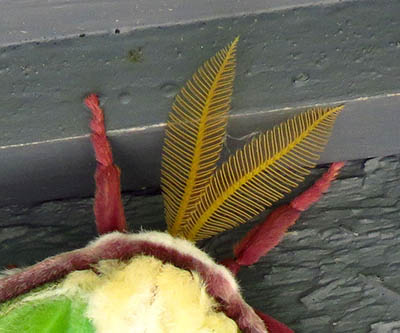 Image by D. Gordon E. Robertson, under CC BY-SA 3.0 license |
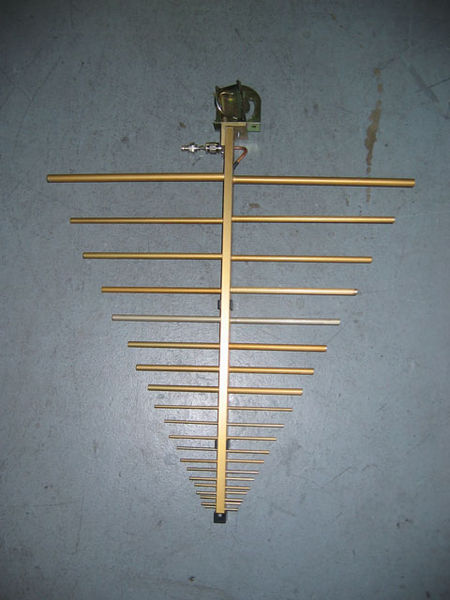 Image by Dante Alighieri, under CC-BY-NC-SA-2.0 license |
Tusks and Horns
The image on the left shows four narwhal tusks. Narwhals are whales that live in the arctic. The long, straight, helical tusk extends from their upper left jaw. It is an incisor tooth and can be up to 3 meters long. Although there are theories about the role of the tusk, the mostly accepted being a secondary sexual characteristic, its precise role is still uncertain. It could be somewhere close to the same reason why seashells are shaped as helicones.
Narwhal tusks are shaped as lowmorph helicones. Since these tusks are not used in combat one might wonder what their function is. It might be that this helical tusk creates vortex movement, and because these turks are solid, not hollow, the vortex movement is most probably a core movement that connects to waves from the electromagnetic spectrum. The function of these narwhal tusks could therefore be radio communication. This would finally explain as to why these animals have these horns extending from them.
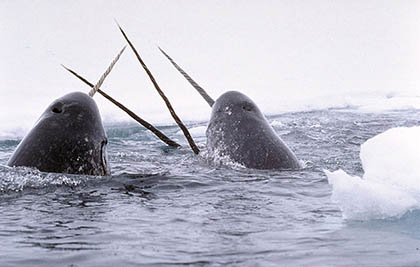 Image by Glenn Williams, for National Institute of Standards and Technology |
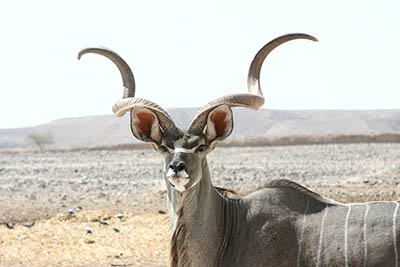 Image by Tamar Assaf, Wikimedia |
The image on the right show a pair of kudu horns. A kudu is a species of antelope. Their horns have quite a remarkable shape, like that of a corkscrew. If you are a critical thinker then you might ask yourself the question as to why their horns are shaped that way. If you consider that the only known function of these horns is combat and self-defense, then its corkscrew shape is illogical, as it is somewhat less stronger than a horn that would be more straight. This shape is more likely to break.
A possible reason why these horns are shaped this way is because they provide two functions: combat and communication. These horns are designed to catch wave signals from the electromagnetic spectrum. The kudu horns have a corkscrew shape because that vortex shape connects to the waves that provide the correct functionality for these antelopes. A lower dimensional wave might be less favorable because it gets blocked too much by obstacles. A higher dimensional wave might be unfavorable because it travels not far enough. Or the wave signals from a straight horn might interfere with the communication signals from other animals. It is quite common in nature for one part of anatomy to provide two or more functions simultaneously. This is one of those examples.
Superb Bird-of-Paradise
The superb bird-of-paradise (Lophorina superba), is a species of bird that displays one of the most bizarre and elaborate courtship dances. First the male bird attracts the female with a loud call. When a female approaches, he spreads his black feather cape and blue-green breast shield symmetrically around his head, thereby his entire appearance changes into an elliptical shape which is slightly curved. Further, he dances around the female in circles, snapping his tail feathers on the ground.
 Image from Planet Earth by BBC Natural History Unit |
_UnderCCBYSA3.0.jpg) Image by Bukvoed, Wikimedia, under CC BY-SA 3.0 license |
What the colors and shapes on the elliptical cape mean is unclear. But the shape of the cape looks closely similar to the shape of a radar antenna. These types of antennas cast a narrow beam forward. It is an antenna that uses high dimensional (high frequency) directional waves. For that reason the male bird attempts to point the cape exactly in the direction of the female.
Yet what exactly the function of the wave signal is is not entirely clear, because it is not detection of the female bird for which these radar signals are used by the male bird, the female already stands in front of the male when the cape is spread out. All we can say is that those high dimensional directional wave signals, which are a form of radar, are use as a courtship ritual for the female bird.
Peacock Spider
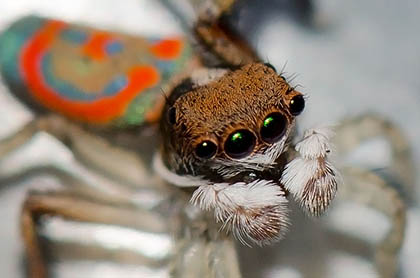
Image by Jean and Fred Hort, under CC BY 2.0 license
The peacock spider is a beautifully colored small spider with a length that is about 4 or 5 mm in size. Males have red, blue and black colors. They have flaps on their abdomen which can be extended or folded down. These flaps are extended out during mating. The male raises his abdomen, then expands and raises the flaps so that the abdomen forms a circular shield of color. It is for this shield of color that the spider is often been compared to a peacock. The third pair of legs is also raised for display, showing a brush of black hairs and white tips. While approaching the female, the male will then vibrate raised legs and tail, and dance from side to side.

The reason the spider performs this ritual was merely thought to be as a visual display, sort of a dance, to attract a female. But while all evidence suggests that it is indeed a mating ritual, the display itself is not meant to be a dance, but a means of communication using wave signals. The peacock spider attracts a female using radio communication. The two hind legs and colorful flaps take on the same shape as a rabbits ear antenna, a type of dipole antenna that we humans also use for radio communication. The video below shows how the peacock spider performs his mating ritual.
The interesting thing is that the shape of a rabbits ear antenna can not be explained by studying the shape of the transformation sequence as we know it today. Its shape is that of a vortex which we have not identified yet. This is one of several clues that suggests that the transformation sequence is larger than we know it to be. There are still pieces of the puzzle waiting to be found.
HUMAN BEINGS DID NOT INVENT RADIO, WE MASTERED RADIO
| All content on this site that is authored by Peter.A.Venis is licensed under the Creative Commons CC BY 4.0 license, unless otherwise mentioned. Most pages on this website also include material from other authors, under different licenses. Both the author's names and the licenses are mentioned in the file names whenever this information is known and can be provided. The presence of work from other authors on this website does not necessarily imply that those authors endorse the contents of this website. |
| A word that is often used on this website is the word 'vortex'. Many sources describe a vortex as a movement in a fluid that has a rotational flow. Yet many of the vortices that I describe on this website do not show a visible rotational flow. I took the liberty of using the word vortex for describing a phenomenon that had not been understood before, one that links together rotational and non-rotational movements. Even a movement in a straight line can in some cases be categorized as a vortex, if it is known that that movement is created by certain identical conditions. So keep in mind that the word 'vortex', within the context of the infinity-theory, has not the exact same meaning as other sources describe. |




